

Www.oracle.com/technetwork/middleware/weblogic/oraclewls-jrebel.pdf. Spring: Spring-WS con JAXB + Hibernate + DAO. Recorriendo Spring Las Aplicaciones empresariales modernos rara vez están solas, a menudo se basan en datos, proporcionados por servicios externos.
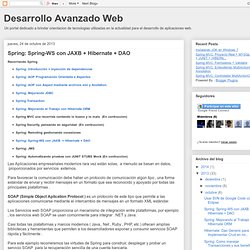
Para favorecer la comunicación debe haber un protocolo de comunicación algún tipo , una forma estándar de enviar y recibir mensajes en un formato que sea reconocido y apoyado por todas las principales plataformas . SOAP (Simple Object Aplication Protocol ) es un protocolo de este tipo que permite a las aplicaciones comunicarse mediante el intercambio de mensajes en un formato XML estándar.
Los Servicios web SOAP proporciona un mecanismo de integración entre plataformas, por ejemplo , los servicios web SOAP se usan comúnmente para integrar . Java - JAXb, Hibernate and beans. Spring DI and CDI Comparative Study. This article shows how to perform basic Dependency Injection (DI) using Spring 3.2 and Context and Dependency Injection (CDI) of Java EE 6.

Basically, this will help someone quickly learn one of the technologies when she knows the other. Note: For Spring, we assume that the application is Spring MVC based. Also, for the sake of brevity I don’t create interfaces for Spring beans. Basic Setup For CDI, a file called beans.xml must be present in WEB-INF folder of a WAR file or META-INF folder of a JAR file.
In a Spring MVC application, specify the location of the configuration file in web.xml as a part of the Spring dispatcher servlet definition. Appengine – improving cold startup with spring enabled apps. First of all, in 2013 I refuse to work like 1983.
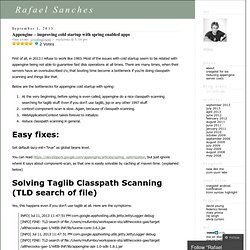
Most of the issues with cold startup seem to be related with appengine being not able to guarantee fast disk operations at all times. There are many times, when their servers have an oversubscribed i/o, that booting time become a bottleneck if you’re doing classpath scanning and things like that. Below are the bottlenecks for appengine cold startup with spring: At the very beginning, before spring is even called, appengine do a nice classpath scanning searching for taglib stuff. Even if you don’t use taglib, jsp or any other 1997 stuff.context:component-scan is slow. Set default-lazy-init=”true” as global beans level. You can read but just ignore where it says about component-scan, as that one is easily solvable by caching at maven time. Yes, this happens even if you don’t use taglib at all. Spring: Choosing the Right Dependency Injection Approach. There are many different ways to perform dependency injection (DI) in Spring.
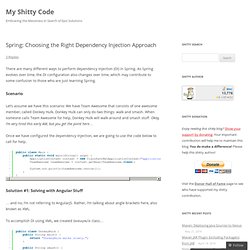
As Spring evolves over time, the DI configuration also changes over time, which may contribute to some confusion to those who are just learning Spring. Scenario Let’s assume we have this scenario: We have Team Awesome that consists of one awesome member, called Donkey Hulk. Donkey Hulk can only do two things: walk and smash. When someone calls Team Awesome for help, Donkey Hulk will walk around and smash stuff. Once we have configured the dependency injection, we are going to use the code below to call for help. Solution #1: Solving with Angular Stuff … and no, I’m not referring to AngularJS. To accomplish DI using XML, we created DonkeyHulk class… … and created TeamAwesome class… Finally, we use XML to wire them up. Solution #2: @Service and @Autowired. Spring beans autowiring concepts. In spring framework, setting bean dependencies in configuration files is a good practice to follow, but the spring container is also able to autowire relationships between collaborating beans.
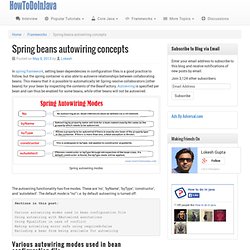
This means that it is possible to automatically let Spring resolve collaborators (other beans) for your bean by inspecting the contents of the BeanFactory. Autowiring is specified per bean and can thus be enabled for some beans, while other beans will not be autowired. Spring autowiring modes The autowiring functionality has five modes. These are ‘no’, ‘byName’, ‘byType’, ‘constructor’, and ‘autodetect’. Spring Autowired annotation is configuration based which creates.
Spring Autowired annotation is configuration based which creates object of the bean.It can be implicitly registered by including the following below tag in an XML-based Spring configuration (notice the inclusion of the ‘context’ namespace): Note : only looks for annotations on beans in the same application context it is defined in.

This means that, if you put in a WebApplicationContext for a DispatcherServlet, it only checks for @Autowired beans in your controllers, and not your services. Chapter 3 - Dependency Injection — The Tao of Testing. Despite what may seem like conventional thinking to the contrary, most of the time when a programmer wants to utilize the behaviour of a particular class they are not storing state.
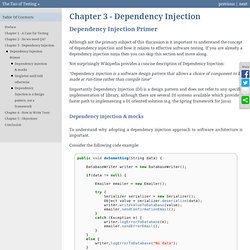
That is, in the process of storing or retrieving state many objects are used which themselves do not maintain state. This may include things like classes which perform operations on external systems like databases or email servers, utility functions and any algorithms or “business rules” that operate on data. These will typically perform operations on stateful objects, but themselves are not stateful. These stateless objects therefore do not need more than one instance of themselves for a given application as all instances would be exactly the same. For this reason they are good candidates for a singleton.
Consider our A,B example as singletons: The mechanics to turn these objects into singletons is not difficult, but it is verbose and creates a lot of additional code. Spring Dependency Injection Example with Annotations and XML Configuration. Spring Framework core concepts are “Dependency Injection” and “Aspect Oriented Programming“.
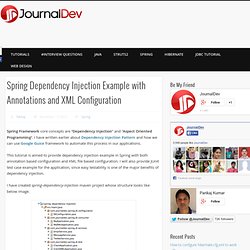
I have written earlier about Dependency Injection Pattern and how we can use Google Guice framework to automate this process in our applications. This tutorial is aimed to provide dependency injection example in Spring with both annotation based configuration and XML file based configuration. I will also provide JUnit test case example for the application, since easy testability is one of the major benefits of dependency injection. Factory Design Pattern in Java. Factory Pattern is one of the Creational Design pattern and it’s widely used in JDK as well as frameworks like Spring and Struts.

Factory design pattern is used when we have a super class with multiple sub-classes and based on input, we need to return one of the sub-class. This pattern take out the responsibility of instantiation of a class from client program to the factory class. Let’s first learn how to implement factory pattern in java and then we will learn it’s benefits and we will see its usage in JDK.
Java Singleton Design Pattern Best Practices with Examples. Singleton is one of the Gangs of Four Design patterns and comes in the Creational Design Pattern category.
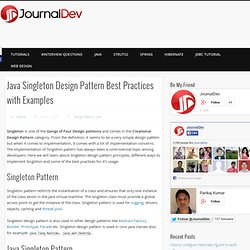
From the definition, it seems to be a very simple design pattern but when it comes to implementation, it comes with a lot of implementation concerns. The implementation of Singleton pattern has always been a controversial topic among developers. Here we will learn about Singleton design pattern principles, different ways to implement Singleton and some of the best practices for it’s usage. Singleton Pattern Singleton pattern restricts the instantiation of a class and ensures that only one instance of the class exists in the java virtual machine.
Dependency Injection Design Pattern in Java Example Tutorial. Dependency Injection design pattern allows us to remove the hard-coded dependencies and make our application loosely coupled, extendable and maintainable. We can implement dependency injection pattern to move the dependency resolution from compile-time to runtime. Dependency injection pattern seems hard to grasp with theory, so I would take a simple example and then we will see how to use dependency injection pattern to achieve loose coupling and extendability in the application. Spring V.S. Java EE.